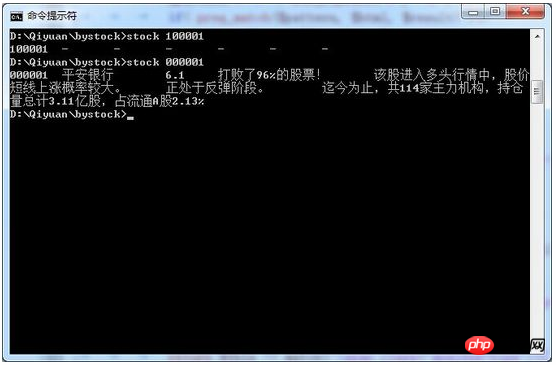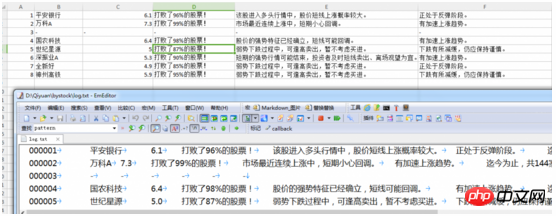 Backend Development
Backend Development
 PHP Tutorial
PHP Tutorial
 PHP uses command line mode to collect stock trend information example code
PHP uses command line mode to collect stock trend information example code
PHP uses command line mode to collect stock trend information example code
Stock information When we make financial management websites, we only collect data from portal sites. It is impossible to generate stock information by ourselves. This will require grabbing data from stock sites. Let's take a look at an article about collecting all data from the PHP command line. Stock trend information program, details are as follows.
The main function has only one class implementation (stock.class.php):
<?php
class StockClass{
public $stockId;
public function construct($stockId){
$this -> stockId = $stockId;
}
private function getUrl(){
return "http://stockpage.10jqka.com.cn/" . $this -> stockId . "/";
}
private function getPage(){
return file_get_contents($this -> getUrl());
}
//核心,通过正则匹配出 标签名,并将对应的方法的结果替换掉标签占位符
public function getInfo($template){
$html = $this -> getPage();
if( preg_match_all("/\{([^\}]*)\}/", $template, $result) ){
foreach($result[1] as $index => $fun){
$template = str_replace($result[0][$index], $this -> $fun($html), $template);
}
}
return mb_convert_encoding($template, "GBK", "UTF-8"); //Windows的命令提示符编码是GBK
}
private function match($pattern, $html, $itemIndex = 1){
$pattern = '/' . str_replace('/', '\/', $pattern) . '/';
if( preg_match($pattern, $html, $result) ){
return $result[$itemIndex];
}else{
return "-";
}
}
//趋势的规则都一样,合并
private function qushiPattern($name){
return '<p class="txt-aside">' . $name . ':</p>\s*<p class="txt-main">([^<]*)</p>';
}
//支持的标签
private function name($html){
return $this -> match("<title>([^\(<]*)\(", $html, 1);
}
private function score($html){
return $this -> match('<span class="analyze-num">(\d+(\.\d+)?)</span>', $html);
}
private function tips($html){
return $this -> match('<span class="analyze-tips">([^<]*)</span>', $html);
}
private function qushishort($html){
return $this -> match($this -> qushiPattern("短期趋势"), $html);
}
private function qushimiddle($html){
return $this -> match($this -> qushiPattern("中期趋势"), $html);
}
private function qushilong($html){
return $this -> match($this -> qushiPattern("长期趋势"), $html);
}
}
?>The calling method in the command prompt is as follows (stock.php):
<?php
if(count($argv) >= 2){
require("stock.class.php");
$stockId = $argv[1];
$stock = new StockClass($stockId);
$temp = $stockId;
$temp .= " {name}"; //名称
$temp .= " {score}"; //评分
$temp .= " {tips}"; //描述
$temp .= " {qushishort}"; //短期趋势
$temp .= " {qushimiddle}"; //中期趋势
$temp .= " {qushilong}"; //长期趋势
//$temp .= " {zidingyi}"; //自定义,直接在StockClass增加zidingyi方法即可
$temp .= "\n";
echo $stock -> getInfo($temp);
}
?>Use directly *\php.exe stock.php The stock code can be called. If the input is too long each time, you can Simplify with batch processing.
Save the following code as stock.cmd.
@XXX\php.exe stock.php %1
Running results:

This completes the collection of individual stock trends. If you want to collect All stock information can be saved as a batch processing file (batch.cmd)
@echo off call stock 000001 call stock 000002 call stock 000003 call stock 000004 call stock 000005 call stock 000006 call stock 000007 call stock 股票代码n...
Double-click to open it to display it. If you want to save it to a file, you can execute batch.cmd > ; log.txt, and then copy the results to Execl (or ET) for more responsible analysis.

The above is the detailed content of PHP uses command line mode to collect stock trend information example code. For more information, please follow other related articles on the PHP Chinese website!

Hot AI Tools

Undresser.AI Undress
AI-powered app for creating realistic nude photos

AI Clothes Remover
Online AI tool for removing clothes from photos.

Undress AI Tool
Undress images for free

Clothoff.io
AI clothes remover

AI Hentai Generator
Generate AI Hentai for free.

Hot Article

Hot Tools

Notepad++7.3.1
Easy-to-use and free code editor

SublimeText3 Chinese version
Chinese version, very easy to use

Zend Studio 13.0.1
Powerful PHP integrated development environment

Dreamweaver CS6
Visual web development tools

SublimeText3 Mac version
God-level code editing software (SublimeText3)

Hot Topics
 1378
1378
 52
52
 PHP 8.4 Installation and Upgrade guide for Ubuntu and Debian
Dec 24, 2024 pm 04:42 PM
PHP 8.4 Installation and Upgrade guide for Ubuntu and Debian
Dec 24, 2024 pm 04:42 PM
PHP 8.4 brings several new features, security improvements, and performance improvements with healthy amounts of feature deprecations and removals. This guide explains how to install PHP 8.4 or upgrade to PHP 8.4 on Ubuntu, Debian, or their derivati
 How To Set Up Visual Studio Code (VS Code) for PHP Development
Dec 20, 2024 am 11:31 AM
How To Set Up Visual Studio Code (VS Code) for PHP Development
Dec 20, 2024 am 11:31 AM
Visual Studio Code, also known as VS Code, is a free source code editor — or integrated development environment (IDE) — available for all major operating systems. With a large collection of extensions for many programming languages, VS Code can be c
 How do you parse and process HTML/XML in PHP?
Feb 07, 2025 am 11:57 AM
How do you parse and process HTML/XML in PHP?
Feb 07, 2025 am 11:57 AM
This tutorial demonstrates how to efficiently process XML documents using PHP. XML (eXtensible Markup Language) is a versatile text-based markup language designed for both human readability and machine parsing. It's commonly used for data storage an
 7 PHP Functions I Regret I Didn't Know Before
Nov 13, 2024 am 09:42 AM
7 PHP Functions I Regret I Didn't Know Before
Nov 13, 2024 am 09:42 AM
If you are an experienced PHP developer, you might have the feeling that you’ve been there and done that already.You have developed a significant number of applications, debugged millions of lines of code, and tweaked a bunch of scripts to achieve op
 Explain JSON Web Tokens (JWT) and their use case in PHP APIs.
Apr 05, 2025 am 12:04 AM
Explain JSON Web Tokens (JWT) and their use case in PHP APIs.
Apr 05, 2025 am 12:04 AM
JWT is an open standard based on JSON, used to securely transmit information between parties, mainly for identity authentication and information exchange. 1. JWT consists of three parts: Header, Payload and Signature. 2. The working principle of JWT includes three steps: generating JWT, verifying JWT and parsing Payload. 3. When using JWT for authentication in PHP, JWT can be generated and verified, and user role and permission information can be included in advanced usage. 4. Common errors include signature verification failure, token expiration, and payload oversized. Debugging skills include using debugging tools and logging. 5. Performance optimization and best practices include using appropriate signature algorithms, setting validity periods reasonably,
 PHP Program to Count Vowels in a String
Feb 07, 2025 pm 12:12 PM
PHP Program to Count Vowels in a String
Feb 07, 2025 pm 12:12 PM
A string is a sequence of characters, including letters, numbers, and symbols. This tutorial will learn how to calculate the number of vowels in a given string in PHP using different methods. The vowels in English are a, e, i, o, u, and they can be uppercase or lowercase. What is a vowel? Vowels are alphabetic characters that represent a specific pronunciation. There are five vowels in English, including uppercase and lowercase: a, e, i, o, u Example 1 Input: String = "Tutorialspoint" Output: 6 explain The vowels in the string "Tutorialspoint" are u, o, i, a, o, i. There are 6 yuan in total
 Explain late static binding in PHP (static::).
Apr 03, 2025 am 12:04 AM
Explain late static binding in PHP (static::).
Apr 03, 2025 am 12:04 AM
Static binding (static::) implements late static binding (LSB) in PHP, allowing calling classes to be referenced in static contexts rather than defining classes. 1) The parsing process is performed at runtime, 2) Look up the call class in the inheritance relationship, 3) It may bring performance overhead.
 What are PHP magic methods (__construct, __destruct, __call, __get, __set, etc.) and provide use cases?
Apr 03, 2025 am 12:03 AM
What are PHP magic methods (__construct, __destruct, __call, __get, __set, etc.) and provide use cases?
Apr 03, 2025 am 12:03 AM
What are the magic methods of PHP? PHP's magic methods include: 1.\_\_construct, used to initialize objects; 2.\_\_destruct, used to clean up resources; 3.\_\_call, handle non-existent method calls; 4.\_\_get, implement dynamic attribute access; 5.\_\_set, implement dynamic attribute settings. These methods are automatically called in certain situations, improving code flexibility and efficiency.



